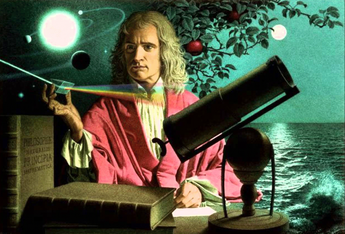WORKSHEETS AND PROBLEMS
FORCE AND MASS
|
Sir Isaac Newton
Sir Isaac Newton's three laws of motion describe the motion of massive bodies and how they interact. While Newton's laws may seem obvious to us today, more than three centuries ago they were considered revolutionary. The First Law of Motion states, "A body at rest will remain at rest, and a body in motion will remain in motion unless it is acted upon by an external force." This simply means that things cannot start, stop, or change direction all by themselves. It takes some force acting on them from the outside to cause such a change. This property of massive bodies to resist changes in their state of motion is sometimes called inertia. |
The Second Law of Motion describes what happens to a massive body when it is acted upon by an external force. It states, "The force acting on an object is equal to the mass of that object times its acceleration." This is written in mathematical form as F = ma, where F is force, m is mass, and a is acceleration. The bold letters indicate that force and acceleration are vector quantities, which means they have both magnitude and direction. The force can be a single force, or it can be the vector sum of more than one force, which is the net force after all the forces are combined.
The Third Law of Motion states, "For every action, there is an equal and opposite reaction." This law describes what happens to a body when it exerts a force on another body. Forces always occur in pairs, so when one body pushes against another, the second body pushes back just as hard. For example, when you push a cart, the cart pushes back against you; when you pull on a rope, the rope pulls back against you; when gravity pulls you down against the ground, the ground pushes up against your feet; and when a rocket ignites its fuel behind it, the expanding exhaust gas pushes on the rocket causing it to accelerate.
The Third Law of Motion states, "For every action, there is an equal and opposite reaction." This law describes what happens to a body when it exerts a force on another body. Forces always occur in pairs, so when one body pushes against another, the second body pushes back just as hard. For example, when you push a cart, the cart pushes back against you; when you pull on a rope, the rope pulls back against you; when gravity pulls you down against the ground, the ground pushes up against your feet; and when a rocket ignites its fuel behind it, the expanding exhaust gas pushes on the rocket causing it to accelerate.
The 4 Fundamental Forces of Nature
• Gravitational Force: It acts between any two piecese of matter as mass is its source. It is why objects fall or why planets turn around the Sun.
• Electromagnetic Force, which cause electric and magnetic effects such as the interactions between magnets.
• Weak Nuclear Force: It is responsible for radioactive decay.
• Strong Nuclear Force: It is responsible for holding the nuclei of atoms together (holds neutrons and protons together)
• Gravitational Force: It acts between any two piecese of matter as mass is its source. It is why objects fall or why planets turn around the Sun.
• Electromagnetic Force, which cause electric and magnetic effects such as the interactions between magnets.
• Weak Nuclear Force: It is responsible for radioactive decay.
• Strong Nuclear Force: It is responsible for holding the nuclei of atoms together (holds neutrons and protons together)
Hooke´s Law
Springs come in a huge variety of different forms, but the simple metal coil spring is probably the most familiar. Springs are an essential part of almost all moderately complex mechanical devices; from ball-point pens to racing car engines..
There is nothing particularly magical about the shape of a coil spring that makes it behave like a spring. The 'springiness', or more correctly, the elasticity is a fundamental property of the wire that the spring is made from. A long straight metal wire also has the ability to ‘spring back’ following a stretching or twisting action. Winding the wire into a spring just allows us to exploit the properties of a long piece of wire in a small space. This is much more convenient for building mechanical devices.
When studying springs and elasticity, the 17ᵗʰ century physicist Robert Hooke noticed that within certain limits, the force required to stretch an elastic object such as a metal spring is directly proportional to the extension of the spring. This is known as Hooke's law and is usually written:
F=kx
Where F is the force, x is the length of extension/compression and k is a constant of proportionality known as the spring constant which is usually given in N/m.
When calculating x, it is important to remember that the spring itself will also have some nominal length (Lo) . The total length (L) of a spring under extension is equal to the nominal length plus the extension, L=Lo+x
For a spring under compression, it would be L=Lo−x.
There is nothing particularly magical about the shape of a coil spring that makes it behave like a spring. The 'springiness', or more correctly, the elasticity is a fundamental property of the wire that the spring is made from. A long straight metal wire also has the ability to ‘spring back’ following a stretching or twisting action. Winding the wire into a spring just allows us to exploit the properties of a long piece of wire in a small space. This is much more convenient for building mechanical devices.
When studying springs and elasticity, the 17ᵗʰ century physicist Robert Hooke noticed that within certain limits, the force required to stretch an elastic object such as a metal spring is directly proportional to the extension of the spring. This is known as Hooke's law and is usually written:
F=kx
Where F is the force, x is the length of extension/compression and k is a constant of proportionality known as the spring constant which is usually given in N/m.
When calculating x, it is important to remember that the spring itself will also have some nominal length (Lo) . The total length (L) of a spring under extension is equal to the nominal length plus the extension, L=Lo+x
For a spring under compression, it would be L=Lo−x.


